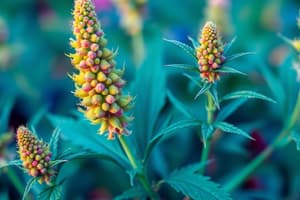Podcast
Questions and Answers
What is one potential outcome of intense liminal crises?
What is one potential outcome of intense liminal crises?
- Enhanced cognitive clarity
- Improved memory retention
- Panic and paranoia (correct)
- Increased social connection
What distinguishes psychedelic agents from other classes of drugs?
What distinguishes psychedelic agents from other classes of drugs?
- Their ability to induce physical dependence
- Their unique capacity to alter perception, thought, and feeling (correct)
- Their recreational use among adolescents
- Their role in treating anxiety disorders exclusively
Which of the following is NOT a characteristic of liminal states of mind?
Which of the following is NOT a characteristic of liminal states of mind?
- Subjective crisis points
- Uncertainty in perception and belief
- Intense emotional stability (correct)
- Challenged assumptions about reality
How have indigenous peoples historically used psychedelics?
How have indigenous peoples historically used psychedelics?
What question reflects the uncertainty in perception that can arise during liminal crises?
What question reflects the uncertainty in perception that can arise during liminal crises?
What is a key characteristic of MDMA that differentiates it from most psychedelics?
What is a key characteristic of MDMA that differentiates it from most psychedelics?
Which of the following compounds is part of the substituted phenethylamines?
Which of the following compounds is part of the substituted phenethylamines?
What is the primary psychoactive component in ayahuasca?
What is the primary psychoactive component in ayahuasca?
Which of the following best describes the effects of psilocybin?
Which of the following best describes the effects of psilocybin?
What is a notable pharmacological feature of bufotenin?
What is a notable pharmacological feature of bufotenin?
What distinguishes the NBOMe compounds from the 2C-x family?
What distinguishes the NBOMe compounds from the 2C-x family?
Which receptor types does MDMA have an agonist affinity for?
Which receptor types does MDMA have an agonist affinity for?
What does the term 'entactogen' refer to in relation to MDMA?
What does the term 'entactogen' refer to in relation to MDMA?
What is a common outcome for atheist individuals after experiencing psychedelics?
What is a common outcome for atheist individuals after experiencing psychedelics?
Which receptor must be coactivated with the 5-HT2A receptor to generate the psychedelic response?
Which receptor must be coactivated with the 5-HT2A receptor to generate the psychedelic response?
Which class of psychedelics is associated with the most receptor interactions?
Which class of psychedelics is associated with the most receptor interactions?
What significant physiological change was noted in the thalamus and medial prefrontal cortex during psychedelic experiences?
What significant physiological change was noted in the thalamus and medial prefrontal cortex during psychedelic experiences?
Which of the following models does the REBUS (Relaxed Beliefs Under Psychedelics) propose a synthesis of?
Which of the following models does the REBUS (Relaxed Beliefs Under Psychedelics) propose a synthesis of?
What is the primary role of the 5-HT2A receptor in psychedelic experiences?
What is the primary role of the 5-HT2A receptor in psychedelic experiences?
In the study mentioned, what was the shared mystical experience reported by users of psychedelics?
In the study mentioned, what was the shared mystical experience reported by users of psychedelics?
What effect does psychedelic use have on the probabilistic transition dynamics between functional brain states?
What effect does psychedelic use have on the probabilistic transition dynamics between functional brain states?
What does the Entropic Brain Hypothesis propose about conscious states?
What does the Entropic Brain Hypothesis propose about conscious states?
How does the Bayesian Brain Hypothesis contribute to optimization in the brain?
How does the Bayesian Brain Hypothesis contribute to optimization in the brain?
Which finding was associated with the use of LSD in reducing anxiety based on the State-Trait Anxiety Inventory?
Which finding was associated with the use of LSD in reducing anxiety based on the State-Trait Anxiety Inventory?
What outcome was predicted by decreased amygdala activity following treatment with psilocybin?
What outcome was predicted by decreased amygdala activity following treatment with psilocybin?
In treatment-resistant patients with depression, what dosages of psilocybin were noted to yield significant decreases in depressive signs?
In treatment-resistant patients with depression, what dosages of psilocybin were noted to yield significant decreases in depressive signs?
What effect did MDMA have in treating social anxiety among autistic adults?
What effect did MDMA have in treating social anxiety among autistic adults?
What is entropy a measure of in relation to the brain's information structure?
What is entropy a measure of in relation to the brain's information structure?
What is indicated by the increase in functional connectivity in the brain as a result of psychedelic drug use?
What is indicated by the increase in functional connectivity in the brain as a result of psychedelic drug use?
What is one potential mechanism by which MDMA may help treat PTSD?
What is one potential mechanism by which MDMA may help treat PTSD?
Which scale showed a significant decrease in functional impairment for subjects receiving MDMA therapy compared to placebo?
Which scale showed a significant decrease in functional impairment for subjects receiving MDMA therapy compared to placebo?
What subjective effect is commonly associated with dissociative substances?
What subjective effect is commonly associated with dissociative substances?
Which psychedelic is noted for potentially providing a protective effect against antisocial criminal behavior?
Which psychedelic is noted for potentially providing a protective effect against antisocial criminal behavior?
What type of receptor does salvinorin A primarily act upon?
What type of receptor does salvinorin A primarily act upon?
Which of the following is a short-term effect of smoking salvia seeds?
Which of the following is a short-term effect of smoking salvia seeds?
What is the role of quadazocine in relation to salvia effects?
What is the role of quadazocine in relation to salvia effects?
What change does MDMA assisted therapy facilitate in patients with eating disorders?
What change does MDMA assisted therapy facilitate in patients with eating disorders?
What long-term change in attitudes is associated with a single instance of psychedelic use?
What long-term change in attitudes is associated with a single instance of psychedelic use?
What neurotransmitter is primarily associated with MDMA's therapeutic effects in PTSD treatment?
What neurotransmitter is primarily associated with MDMA's therapeutic effects in PTSD treatment?
What is the primary psychoactive metabolite of ibogaine in the body?
What is the primary psychoactive metabolite of ibogaine in the body?
Which receptor does dextromethorphan primarily act as a non-competitive antagonist for?
Which receptor does dextromethorphan primarily act as a non-competitive antagonist for?
What effect does high-dose dextromethorphan share with classical psychedelics?
What effect does high-dose dextromethorphan share with classical psychedelics?
Which effect is commonly associated with phencyclidine (PCP) use?
Which effect is commonly associated with phencyclidine (PCP) use?
Which receptor does ketamine NOT act upon?
Which receptor does ketamine NOT act upon?
What is a characteristic neuropharmacological effect of ibogaine?
What is a characteristic neuropharmacological effect of ibogaine?
What is the proposed effect of ketamine on patients with depression?
What is the proposed effect of ketamine on patients with depression?
How does phencyclidine (PCP) affect memory according to its subjective effects?
How does phencyclidine (PCP) affect memory according to its subjective effects?
Which potential risk is associated with high doses of ketamine?
Which potential risk is associated with high doses of ketamine?
What is the characteristic subjective effect of ibogaine?
What is the characteristic subjective effect of ibogaine?
Flashcards
Liminal states
Liminal states
Subjective crisis points in perception and belief, where the certainty of reality is questioned.
Psychedelic agents
Psychedelic agents
Drugs that reliably alter perception, thought, and feelings, producing altered states.
Liminal crisis outcomes
Liminal crisis outcomes
Possible reactions to intense liminal states, ranging from panic or denial to surrender or wisdom.
Psychedelic use
Psychedelic use
Signup and view all the flashcards
Drugs and dreams similarity
Drugs and dreams similarity
Signup and view all the flashcards
MDMA's effect on monoamines
MDMA's effect on monoamines
Signup and view all the flashcards
MDMA neurotoxicity
MDMA neurotoxicity
Signup and view all the flashcards
Substituted Phenethylamines (2C-x)
Substituted Phenethylamines (2C-x)
Signup and view all the flashcards
Psilocybin
Psilocybin
Signup and view all the flashcards
Ayahuasca's active ingredient
Ayahuasca's active ingredient
Signup and view all the flashcards
Tryptamines
Tryptamines
Signup and view all the flashcards
Bufotenin source
Bufotenin source
Signup and view all the flashcards
5-MeO-DMT
5-MeO-DMT
Signup and view all the flashcards
5-HT2A Receptor
5-HT2A Receptor
Signup and view all the flashcards
mGlu2 Receptor
mGlu2 Receptor
Signup and view all the flashcards
Functional Heterodimer
Functional Heterodimer
Signup and view all the flashcards
Ego-Dissolution
Ego-Dissolution
Signup and view all the flashcards
Default Mode Network (DMN)
Default Mode Network (DMN)
Signup and view all the flashcards
Probabilistic Transition Dynamics
Probabilistic Transition Dynamics
Signup and view all the flashcards
REBUS Model
REBUS Model
Signup and view all the flashcards
Free-Energy Principle
Free-Energy Principle
Signup and view all the flashcards
Bayesian Brain Hypothesis
Bayesian Brain Hypothesis
Signup and view all the flashcards
Entropy in the Brain
Entropy in the Brain
Signup and view all the flashcards
Psychedelic-Induced Entropy Gain
Psychedelic-Induced Entropy Gain
Signup and view all the flashcards
Clinical Applications: Anxiety Reduction
Clinical Applications: Anxiety Reduction
Signup and view all the flashcards
Clinical Applications: Depression Reduction
Clinical Applications: Depression Reduction
Signup and view all the flashcards
Amygdala Activity in Depression
Amygdala Activity in Depression
Signup and view all the flashcards
MDMA for Social Anxiety
MDMA for Social Anxiety
Signup and view all the flashcards
MDMA's effect on PTSD
MDMA's effect on PTSD
Signup and view all the flashcards
MDMA's Mechanism
MDMA's Mechanism
Signup and view all the flashcards
Psychedelic use and crime
Psychedelic use and crime
Signup and view all the flashcards
Psychedelics and Suicide
Psychedelics and Suicide
Signup and view all the flashcards
Dissociatives' effect
Dissociatives' effect
Signup and view all the flashcards
Salvia Divinorum's effects on tolerance
Salvia Divinorum's effects on tolerance
Signup and view all the flashcards
Ibogaine
Ibogaine
Signup and view all the flashcards
Noribogaine
Noribogaine
Signup and view all the flashcards
NMDA Antagonist
NMDA Antagonist
Signup and view all the flashcards
Dextromethorphan (DXM)
Dextromethorphan (DXM)
Signup and view all the flashcards
Dissociative
Dissociative
Signup and view all the flashcards
Phencyclidine (PCP)
Phencyclidine (PCP)
Signup and view all the flashcards
Ketamine
Ketamine
Signup and view all the flashcards
Lateral Habenula
Lateral Habenula
Signup and view all the flashcards
Mesocortical Pathway
Mesocortical Pathway
Signup and view all the flashcards
Tyrosine Hydroxylase
Tyrosine Hydroxylase
Signup and view all the flashcards
Study Notes
Psyc 383 - Lecture 9: Hallucinogens
- Course: Psychopharmacology
- Topic: Hallucinogens
- Subtopics: Psychedelics & Dissociatives
The Liminality Crisis
- Question: How to differentiate real from illusory experiences?
- Answer: Liminal states of mind are subjective crisis points, the peak of uncertainty in perception and belief.
- Subjectivity is questioned: The internal nature of perception is challenged as a person considers if their mind is perceiving or creating, and where their self ends and the environment begins.
Psychedelics
- Definition: The distinguishing feature is the capacity to reliably induce altered perception, thought, and feeling not usually experienced except in dreams or religious exaltation.
- Expert: Jerome Jaffe (1990)
Drugs and Dream Similarity (Sanz et al., 2018)
- Study: Research comparing the similarity of drug effects to dream states.
- Data: Charts and graphs illustrate similarity measurements, with categories like serotonergic, entactogen, dissociative, oneirogen, deliriant, depressant, stimulant, antipsychotic / MAOI, and other drug classifications.
- Substances: The graph includes bar graphs and lines representing various substances, indicating strengths of similarity in low lucidity dreams and high lucidity dreams by names and chemical abbreviations.
Brief History of Psychedelics
- Timeline: A chronological overview of psychedelic drug discoveries, isolations, syntheses, and historical uses in research and therapy.
- Key milestones: Dates for various stages are highlighted on a time scale, correlating with the discoveries, synthesis, and the introduction of the term "dissociative anaesthetic" by various scientists.
- Substances: LSD, psilocin, psilocybin, PCP, and ketamine are mentioned and their timelines of isolation and synthesis are displayed through the graphic.
Psychedelics: Additional Notes
- Clinical history: Early researchers termed psychedelics "psychotomimetics" due to their ability to induce schizophrenic-like symptoms.
- Later clinical uses included treatment for conditions like alcoholism, various addiction types, autism, and improving alcoholism, OCD signs during psychotherapy using psilocybin or LSD.
- MDMA, an entactogen, is used by psychiatrists.
Classes of Psychedelic Drugs
- Structures: Two main classes distinguished by minor structural differences: phenethylamines and tryptamines.
- Chemical structures: Chemical structure diagrams are presented for each group, highlighting the key chemical features of each class. The diagrams include different chemical structures for LSD, psilocin, and other psychedelic compounds (salvinorin A, bufotenin, DMT, etc), demonstrating their molecular differences.
Specific Psychedelic-Class Drugs
- Phenethylamines (Mescaline, MDMA, etc.):
- Mescaline: Prototypical phenethylamine found in cactus species (peyote, San Pedro). It has a half-life of about six hours.
- MDMA: Often referred to as an entactogen, potent releaser of monoamines and also binds to various receptor sites. It can have neurotoxic effects and cause serotonin syndrome at high doses.
- Substituted Phenethylamines: Family of research compounds similar to phenethylamines, varying in the position of the NH2 group
- These compounds are typically highly potent psychedelics, and some are lethal at high doses.
- Tryptamines (Psilocybin-psilocin, Bufotenin, DMT, 5-MeO-DMT):
- Psilocybin/Psilocin: Derived from mushrooms; consistently ranked as one of the least harmful illegal drugs, less harmful than alcohol/tobacco
- Bufotenin: Produced by a Sonoran desert toad; similar effects to other tryptamines, readily excreted through the skin
- DMT & 5-MeO-DMT: Important component of ayahuasca brew; often smoked, producing intense psychedelic effects
- Lysergic Acid Diethylamide (LSD): Derived from a rye fungus; often in blotter paper form.
- Bicycle Day: Date when Albert Hoffman experienced LSD's effects for the first time
Psychological effects of Psychedelics
- Mystical Experiences: Hallucinogens often induce profound mystical experiences.
- Common effects: Varying from visions of colors, seeing objects moving and other perceptions, losing track of time and space, changes in feeling of sense of self, and altering relationships with the environment.
- Psychological effects: Includes changes in suggestibility, increased emotional responses to music and other stimulations, perception of closeness, gratitude, purpose, forgiveness, feelings about death, transcendence, satisfaction, mindfulness, psychological distress reduction, general psychopathological symptom reduction
Psychological Effects: Perception
- Visual Perception: Changes in visual perception, including Binocular rivalry reduction or increase.
- Other effects: Changes in sense of time, spatial orientation, and emotional responses to sensory stimuli.
Psychological Effects: Personality
- Openness to experience: Psilocybin use consistently leads to an increase.
- Other effects: Improvements also seen in extraversion and conscientiousness, with a decrease in neuroticism following acute psilocybin experience.
Psychedelics & Nature-Relatedness
- Research: Correlation between psychedelic use and positive environmental attitude.
- Pro-environmental behavior and climate change knowledge were improved.
- Nature-relatedness increased after psychedelic use.
Psychological Effects: "Mystical"
- Sequence of Experiences: A typical sequence of events during a mystical experience is described (e.g. sensory realm, symbolic, and integral levels).
- Broad Range of Experiences: Many variations and interpretations exist around what constitutes a "mystical" experience.
Mechanisms of Action
- Receptors: Major targets are 5-HT2A receptors, but others are also impacted.
- Chemical interactions: Interactions with other receptors like mGlu2, and catecholamines is also significant.
- Understanding this aids in understanding specific actions.
Neurophysiology
- Changes in brain activity: Psychedelics cause changes in the thalamus, ACC, PCC, and medial prefrontal cortex, and the DMN.
- Functional states: A shift in typical brain activity states and patterns occur from psychedelic use.
Novel Functional Dynamics
- Brain state changes: Psychedelics induce novel brain states, and transition dynamics are not typical of regular brain activity.
REBUS: Relaxed Beliefs Under Psychedelics
- Model: Integrating previous brain models, the 'REBUS' model suggests that psychedelics induce more relaxed beliefs.
- Mechanism: Predicts minimization of prediction error and increased expected reward.
Hierarchical Predictive Coding
- Description: Psychedelics cause disruption in hierarchical predictive coding, possibly related to the changes in subjective experiences.
The Entropic Brain Hypothesis
- Definition: A model where consciousness is placed on a spectrum of entropy, ranging from fixed to flexible.
- Mechanism: Psychedelic drugs' effects are seen as an increase in the 'entropy' of the brain due to increased functional connectivity.
Clinical Applications
- Conditions: Psychedelics show promise in treating conditions as shown through studies.
- Anxiety, depression, PTSD are included as target conditions.
- Treatment effects: Reports of reduced anxiety, depression, and PTSD symptoms following psychedelic assisted therapy.
Dissociatives
- Effects: Include depersonalization, derealization, and detachment from the self, surroundings, and reality.
- Mechanism: Often involve NMDA antagonism, with variable affinities for the specific drug.
- Examples: Salvia divinorum, Ketamine, PCP.
Specific Drug Profiles
- Salvia divinorum: Native to Oaxaca, Mexico; psychoactive compound is salvinorin A, an opioid K-receptor agonist.
- Ibogaine: Derived from Central African shrub Tabernanthe iboga; rapidly converted to noribogaine; used to treat addictions, including opioid abuse and alcoholism.
- Dextromethorphan (DXM): Over-the-counter cough suppressant; shows opioid-like effects and NMDA antagonism at higher doses.
- Phencyclidine (PCP): Potent dissociative; acts as a non-competitive NMDA and σ1 receptor antagonist.
- Ketamine: A popular dissociative; less potent than PCP; used for sedation; shows antidepressant properties in some cases.
Studying That Suits You
Use AI to generate personalized quizzes and flashcards to suit your learning preferences.




